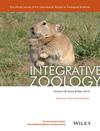Effects of subtle variation in forest canopy openness on cache pilferage and its implications for forest regeneration
IF 3.5
1区 生物学
Q1 ZOOLOGY
引用次数: 0
Abstract
Scatter‐hoarding rodents play important roles in plant regeneration and species coexistence in many forest ecosystems. Cache pilferage, the behavior of rodents seeking or relocating seeds cached by other individuals, is ubiquitous during the scatter‐hoarding process. The effects of canopy openness on cache pilferage have received considerable attention, most of which have focused on the comparison between full canopy cover and completely open areas, such as forest gaps. However, little attention has been given to whether the subtle variation in forest canopy openness affects cache pilferage, although subtle variation in light environments exists in many forests, especially tropical and subtropical forests, where the overall canopy is large and the forest window is relatively small. Here, we directly tested these questions by simulating 400 artificial caches, each containing one seed from four selected tree species, in a subtropical forest in southwestern China. The overall canopy openness of the forest was relatively small (with a mean value of 11.1%), but subtle spatial variation still existed (ranging from 5.7% to 19.5%). Overall, caches with lower canopy openness were more likely to be pilfered and removed faster, although not all species showed the same pattern. Our study highlights that subtle variation in forest canopy openness, even in a closed primary forest, has significant effects on cache pilferage by rodents, which may influence the following seed germination and forest regeneration processes. Additionally, seedling species composition may further be altered because the canopy effects on cache pilferage are species‐specific.林冠开阔度的微妙变化对贮藏室偷盗的影响及其对森林再生的意义
在许多森林生态系统中,散居啮齿动物在植物再生和物种共存方面发挥着重要作用。在散囤过程中,啮齿动物寻找或转移其他个体贮藏的种子的行为--贮藏室偷盗行为无处不在。树冠开阔度对藏匿物偷盗的影响已经受到了相当多的关注,其中大部分都集中在全树冠覆盖与完全开阔区域(如林隙)之间的比较上。然而,人们很少关注森林树冠开阔度的微妙变化是否会影响贮藏室盗窃,尽管在许多森林,特别是热带和亚热带森林中存在着光环境的微妙变化,这些森林的整体树冠很大,而森林窗口相对较小。在此,我们在中国西南部的亚热带森林中模拟了 400 个人工藏匿点,每个藏匿点含有四种选定树种的一粒种子,从而直接测试了这些问题。森林的总体树冠开阔度相对较小(平均值为 11.1%),但仍然存在微妙的空间差异(从 5.7% 到 19.5%)。总体而言,树冠开阔度较低的藏匿点更容易被盗,而且被移除的速度也更快,但并非所有物种都表现出相同的模式。我们的研究突出表明,即使是在郁闭的原始森林中,林冠开阔度的微妙变化也会对啮齿动物盗取储藏处产生重大影响,这可能会影响种子的萌发和森林的再生过程。此外,由于树冠对啮齿动物盗食贮藏室的影响具有物种特异性,因此幼苗的物种组成可能会进一步改变。
本文章由计算机程序翻译,如有差异,请以英文原文为准。
求助全文
约1分钟内获得全文
求助全文
来源期刊

Integrative zoology
ZOOLOGY-
CiteScore
6.40
自引率
12.10%
发文量
81
审稿时长
>12 weeks
期刊介绍:
The official journal of the International Society of Zoological Sciences focuses on zoology as an integrative discipline encompassing all aspects of animal life. It presents a broader perspective of many levels of zoological inquiry, both spatial and temporal, and encourages cooperation between zoology and other disciplines including, but not limited to, physics, computer science, social science, ethics, teaching, paleontology, molecular biology, physiology, behavior, ecology and the built environment. It also looks at the animal-human interaction through exploring animal-plant interactions, microbe/pathogen effects and global changes on the environment and human society.
Integrative topics of greatest interest to INZ include:
(1) Animals & climate change
(2) Animals & pollution
(3) Animals & infectious diseases
(4) Animals & biological invasions
(5) Animal-plant interactions
(6) Zoogeography & paleontology
(7) Neurons, genes & behavior
(8) Molecular ecology & evolution
(9) Physiological adaptations
 求助内容:
求助内容: 应助结果提醒方式:
应助结果提醒方式:


